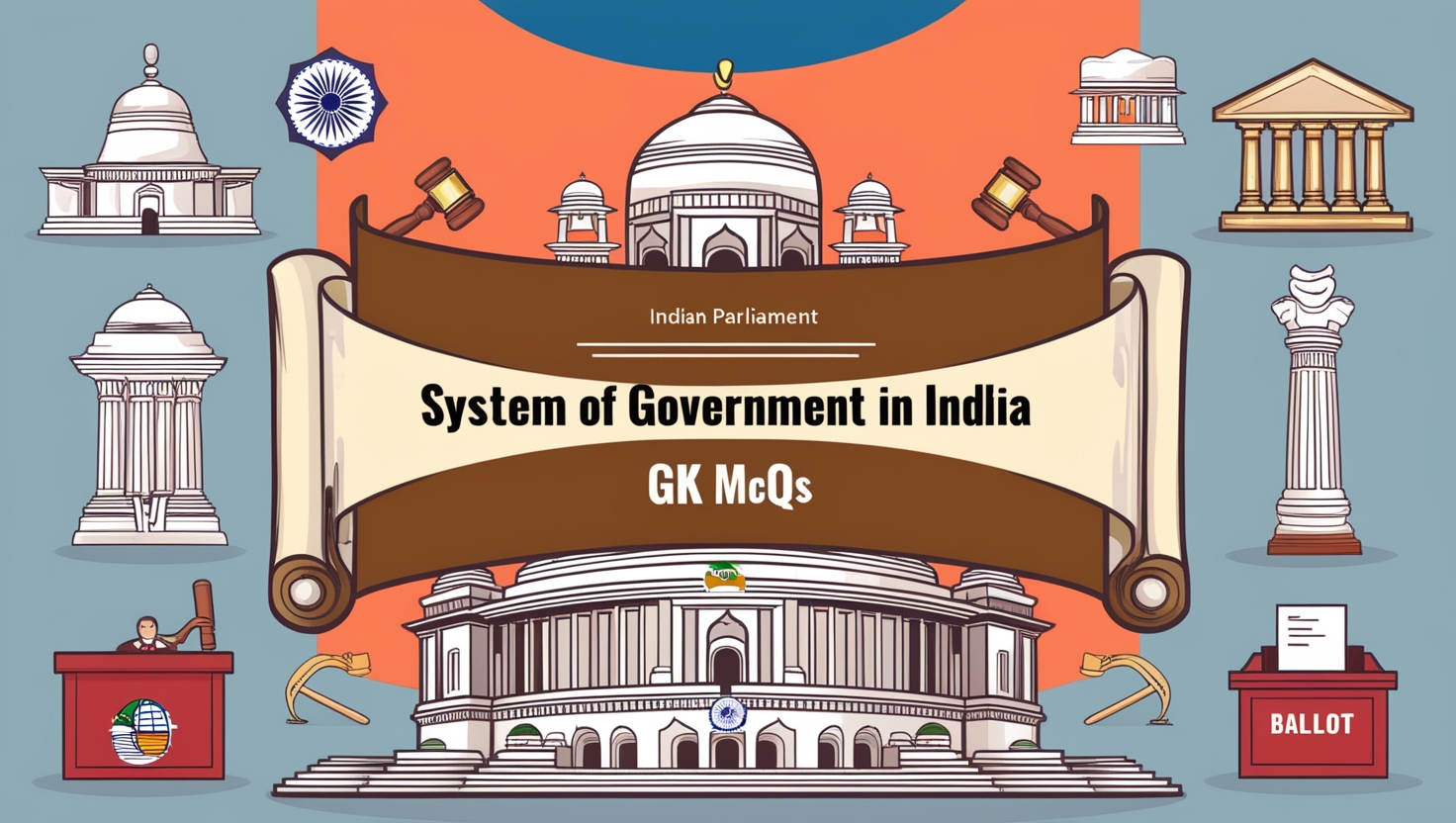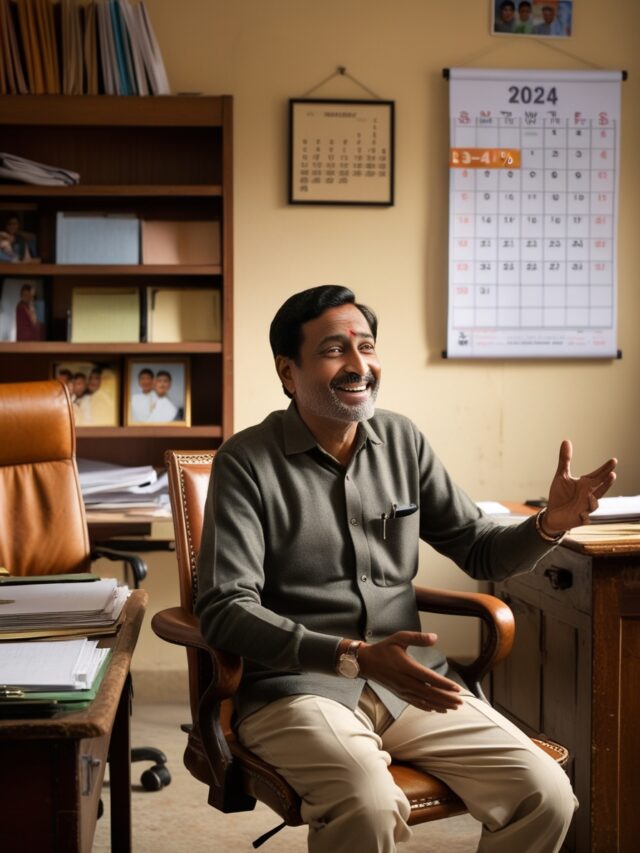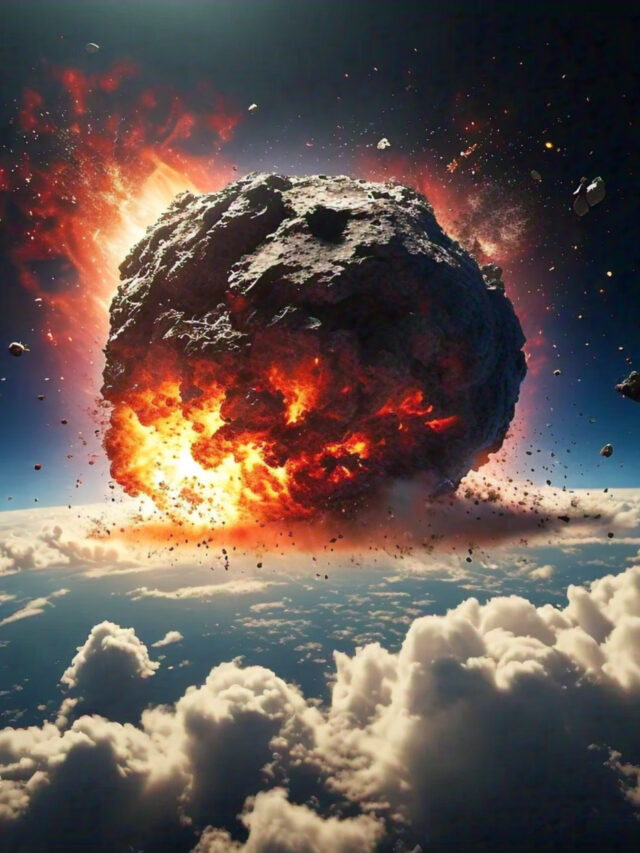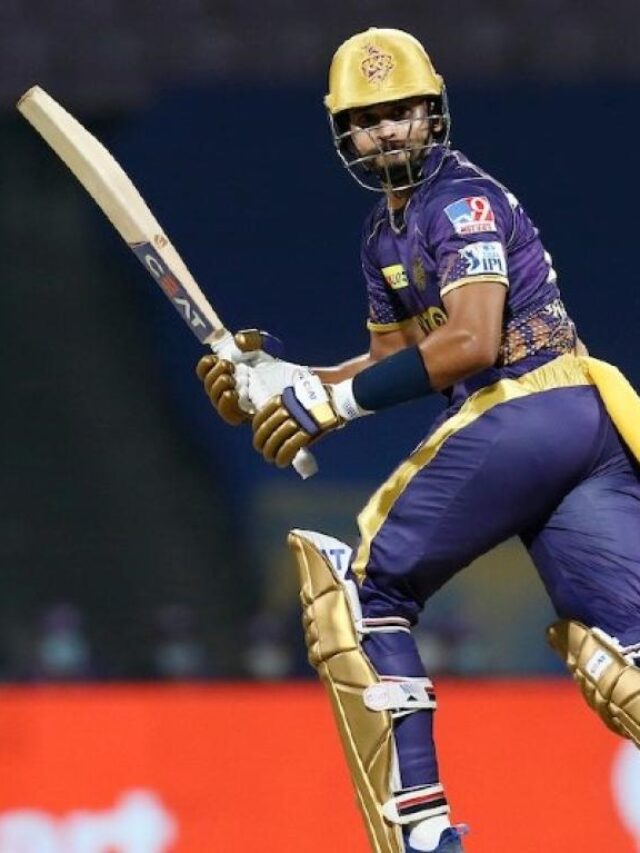
1. Which Articles of the Constitution deal with the parliamentary system at the Centre?
- Articles 163 and 164
- Articles 74 and 75
- Articles 73 and 74
- Article 67 and 68
Show Answer
Answer: Articles 74 and 75
The Indian Constitution establishes a parliamentary form of government both at the central level and in the states. Articles 74 and 75 specifically deal with the parliamentary system at the Centre, while Articles 163 and 164 pertain to the parliamentary system in the states. In this system, the executive, which includes the Prime Minister and the Council of Ministers, is responsible to the legislature (Parliament or State Legislature) for its policies and actions.
2. Which Articles deal with the parliamentary system of government at the level of states?
- Articles 163 and 164
- Articles 165 and 166
- Articles 175 and 176
- Articles 177 and 178
Show Answer
Answer: Articles 163 and 164
Articles 74 and 75 of the Constitution of India deal with the parliamentary system of government at the Centre, and Articles 163 and 164 deal with the parliamentary system in the states. In this system, the executive is responsible to the legislature for its policies and actions.
3. Which system of government is also known as the Westminster model of government?
- Presidential system
- Monarchy
- Parliamentary system
- Oligarchy
Show Answer
Answer: Parliamentary system
The parliamentary government, also known as the cabinet government or responsible government or Westminster model of government, is prevalent in countries such as Britain, Japan, Canada, India, among others.
4. Which country follows the model of the presidential form of government?
- Britain
- Japan
- India
- USA
Show Answer
Answer: USA
The presidential form of government, often called the non-responsible or non-parliamentary or fixed executive system, is common in countries like the United States, Brazil, Russia, and Sri Lanka. In the presidential system, the President serves as both the head of state and head of government, and executive members are not responsible to the legislature for their actions
5. Who called the parliamentary system the ‘cabinet system’?
- Lord Morely
- Ivor Jennings
- Sir William Vernor Harcourt
- H.J. Laski
Show Answer
Answer: Ivor Jennings
Ivor Jennings aptly referred to the parliamentary system as the ‘cabinet system’ because the cabinet is the core of power and governance in a parliamentary setup. This system operates on the principle of collective ministerial responsibility to the legislature, enhancing accountability.
6. Which form of government is also known as ‘responsible government’?
- Presidential government
- Autocracy
- Parliamentary government
- None of the above
Show Answer
Answer: Parliamentary government
In India, the parliamentary system is often termed ‘responsible government’ because the cabinet, which is the actual executive, is answerable to the Parliament. The cabinet remains in office as long as it retains the confidence of the Parliament. The system emphasizes accountability and the need to maintain the Parliament’s trust.
7. Who is the head of the government according to the Constitution of India?
- Chief Justice of India
- President
- Vice President
- Prime Minister
Show Answer
Answer: Prime Minister
As per the Indian Constitution, the President holds the position of nominal executive, while the Prime Minister is the actual executive and the head of the Indian government. The President’s role is largely ceremonial, and the Prime Minister holds the real power.
8. The principle of collective responsibility is enshrined in which article of the Constitution?
- Article 75
- Article 76
- Article 77
- Article 78
Show Answer
Answer: Article 75
The Council of Ministers, collectively, is responsible to the Parliament, particularly the Lok Sabha, in accordance with Article 75 of the Constitution. The ministers function as a team and collectively face accountability, meaning they share success or failure.
9. Who is the leader of the Parliament?
- President
- Vice President
- Prime Minister
- Speaker
Show Answer
Answer: Prime Minister
The Prime Minister of India plays a significant leadership role in the parliamentary system. They serve as the leader of the Council of Ministers, leader of the Parliament, and leader of the ruling political party or coalition.
10. Which of the following are the features of the presidential form of government?
1. The President is both the head of the State and the head of the government.
2. The President is elected by an electoral college for a fixed tenure of four years.
3. The President and his secretaries are not responsible to the Congress for their acts.
4. It does not provide a stable government.
Choose the correct option:
- Only 1
- Only 1 & 2
- 1, 2 & 3
- Only 2 & 3
Show Answer
Answer: 1, 2 & 3
The U.S. Constitution establishes a presidential form of government. Key features include the President serving as both the head of state and government, election by an electoral college for a fixed four-year term, and a separation of powers where the President and their secretaries are not accountable to the Congress for their actions. It is incorrect to say that the presidential system does not provide a stable government, as it does offer stability.
Q11: Which amendment of the Constitution is also called the Mini Constitution?
1. 52nd Amendment Act 1985
2. 42nd Amendment Act 1976
3. 1st Amendment Act 1951
4. 44th Amendment Act 1978
Show Answer
Answer: 2
Explanation: The 42nd Amendment to the Indian Constitution is often referred to as the mini constitution because it brought about extensive and significant changes. This amendment, passed in 1976, amended various aspects of the Constitution, including the Preamble, Fundamental Duties, and the description of India as a Sovereign, Socialist, Secular, and Democratic Republic.
Q12: Which of the following Constitutional Amendment Acts provided for the reservation of seats for scheduled tribes of Nagaland, Meghalaya, Mizoram, & Arunachal Pradesh state assemblies?
1. 52nd
2. 57th
3. 63rd
4. 65th
Show Answer
Answer: 2
Explanation: The Fifty-Seventh Amendment Act of 1987 was enacted to reserve seats for Scheduled Tribes in the legislative assemblies of the northeastern states of Arunachal Pradesh, Meghalaya, Mizoram, and Nagaland. This amendment was a crucial step in ensuring political representation for these tribal communities in these regions.
Q13: Which Constitutional Amendment gave the Right to Education to children in India?
1. 86th
2. 90th
3. 91st
4. 94th
Show Answer
Answer: 1
Explanation: The Constitution (86th) Amendment Act of 2002 reiterated the importance of elementary education as a fundamental right. This amendment introduced Article 21-A, mandating the State to provide free and compulsory education to all children aged six to fourteen years, reinforcing the commitment to universal education.
Q14: Which amendment restored the power of judicial review of the Supreme Court and High courts that was earlier curtailed by the Constitution (42nd) Amendment Act, 1976?
1. Forty-third Amendment Act, 1977
2. Forty-fifth Amendment Act, 1980
3. Forty-sixth Amendment Act, 1982
4. Forty-fourth Amendment Act, 1987
Show Answer
Answer: 1
Explanation: The Constitution (43rd) Amendment Act of 1977 restored the jurisdiction of the Supreme Court and the High Courts in matters of judicial review and the issuance of writs. This amendment reversed certain changes made by earlier amendments and reinstated the role of the judiciary in safeguarding the Constitution and citizens’ rights.
Q15: Which amendment of the Constitution abolished the special privileges of ICS officers and empowered the Parliament to determine their service conditions?
1. Twenty-eighth Amendment Act, 1972
2. Twenty-fourth Amendment Act, 1971
3. Twenty-ninth Amendment Act, 1972
4. Twenty-fifth Amendment Act, 1971
Show Answer
Answer: 1
Explanation: The Constitution (28th) Amendment Act, 1972, abolished the special privileges of ICS officers and empowered the Parliament to determine their service conditions. It included provisions for the deletion of Article 314 and the inclusion of a new Article 312-A, which confers powers on Parliament to vary or revoke the conditions of Civil Services.
Q16: By which amendment act was the 10th schedule added in the Indian Constitution, giving special status to Sikkim?
1. 35th Amendment Act
2. 34th Amendment Act
3. 36th Amendment Act
4. 37th Amendment Act
Show Answer
Answer: 3
Explanation: The Constitution (36th) Amendment Act, 1975, terminated the protectorate status of Sikkim and conferred on it the status of an associate state of the Indian Union. The Tenth Schedule was added, laying down the terms and conditions of association of Sikkim with the Indian Union.
Q17: Which among the following acts incorporated the 11th Fundamental duty in the Indian Constitution?
1. 42nd Amendment Act
2. 51st Amendment Act
3. 44th Amendment Act
4. 86th Amendment Act
Show Answer
Answer: 4
Explanation: The Constitution (86th) Amendment Act added a new fundamental duty under Article 51-A, which reads – It shall be the duty of every citizen of India who is a parent or guardian to provide opportunities for education to his child or ward between the age of six and fourteen years.
Q18: Which article was inserted in the Indian Constitution by the 42nd amendment in 1976, in the purview of India being a signatory of the Stockholm Conference of 1972?
1. Article 45
2. Article 47
3. Article 45 A
4. Article 48A
Show Answer
Answer: 4
Explanation: Initially, the Constitution of India had no direct provision for environmental protection. The global consciousness for the protection of the environment in the seventies, Stockholm Conference, and increasing awareness of the environmental crisis prompted the Indian Government to enact the 42nd Amendment to the Constitution in 1976. The Constitution was amended to introduce direct provisions for the protection of the environment. This 42nd Amendment added Article 48A to the Directive Principles of State Policy.
Q19: Which of the following Constitution Amendment Acts grants citizens the fundamental right to form cooperative societies?
1. 95th Amendment Act
2. 96th Amendment Act
3. 97th Amendment Act
4. 98th Amendment Act
Show Answer
Answer: 3
Explanation: The Constitution (97th) Amendment Act, 2011, gave a constitutional status and protection to co-operative societies. This amendment made the right to form co-operative societies a fundamental right (Article 19) and included a new Directive Principle of State Policy on the promotion of co-operative societies (Article 43-B). It also added a new Part IX-B in the constitution entitled The Co-operative Societies (Articles 243-ZH to 243-ZT).
Q20: Via which among the following amendments of the Constitution of India, Delhi was designated as National Capital Territory (NCT)?
1. 63rd Amendment Act
2. 69th Amendment Act
3. 74th Amendment Act
4. 76th Amendment Act
Show Answer
Answer: 2
Explanation: The Constitution (69th) Amendment Act, 1991, accorded a special status to the Union Territory of Delhi by designating it as the National Capital Territory of Delhi.
Q21: Which Amendment Act added the ninth schedule to the Constitution of India?
1. First Amendment
2. Second Amendment
3. Eighth Amendment
4. Ninth Amendment
Show Answer
Answer: 1
Explanation: The first Constitution Amendment Act of 1951 added two new Articles 31(a) and 31(b) and the 9th schedule to the Constitution for the protection of agrarian reforms in certain States.
Q22: Which of the following Constitutional Amendment Acts was called the ‘Mini Constitution’?
1. 42nd Amendment Act
2. 46th Amendment Act
3. 69th Amendment Act
4. 91st Amendment Act
Show Answer
Answer: 1
Explanation: The 42nd Constitutional Amendment Act of 1976 altered and added several provisions of the Constitution. It was introduced to overcome the difficulties arising from the decision of the Supreme Court in the Kesavananda Bharati Case of 1973.
Q23: Which Constitutional Amendment Act reduced the voting age from 21 years to 18 years?
1. 42nd Amendment Act
2. 44th Amendment Act
3. 46th Amendment Act
4. 61st Amendment Act
Show Answer
Answer: 4
Explanation: he sixty-First Constitutional Amendment Act of 1989 reduced the voting age from 21 years to 18 years for the Lok Sabha and State Legislative Assembly elections.
Q24: Which Amendment to the Constitution of India added public order, friendly relations with foreign states, and incitement to an offence as additional grounds to put curbs on freedom of speech?
1. 1st Amendment Act, 1951
2. 2nd Amendment Act, 1952
3. 3rd Amendment Act, 1954
4. 4th Amendment Act, 1955
Show Answer
Answer: 1
Explanation: The First Constitutional Amendment Act of 1951 added three more grounds of restrictions on freedom of speech and expression, viz., public order, friendly relations with foreign states, and incitement to an offence. It also made the restrictions ‘reasonable’ and thus, justifiable in nature.
Q25: Which Constitutional Amendment empowered the state to make special provisions for the advancement of socially and economically backward classes?
1. 1st Amendment Act, 1951
2. 6th Amendment Act, 1956
3. 9th Amendment Act, 1960
4. 14th Amendment Act, 1962
Show Answer
Answer: 1
Explanation: The First Constitutional Amendment Act of 1951 empowered the state to make special provisions for the advancement of socially and economically backward classes. It also added three more grounds of restrictions on freedom of speech and expression.
Q26: Which schedule was added by the 1st Amendment to the Constitution of India?
1. 7th Schedule
2. 8th Schedule
3. 9th Schedule
4. 10th Schedule
Show Answer
Answer: 3
Explanation: The First Constitutional Amendment Act of 1951 added the 9th Schedule to the Constitution of India. It was added to protect the land reforms and other laws included in it from judicial review.
Q27: Which Constitutional Amendment Act provided for the establishment of common high courts for two or more states?
1. 5th Amendment
2. 6th Amendment
3. 7th Amendment
4. 9th Amendment
Show Answer
Answer: 3
Explanation: The 7th Constitutional Amendment Act of 1956 provided for the establishment of a common high court for two or more states. It also provided for the appointment of additional and acting judges of the high court.
Q28: Which Constitutional Amendment abolished the existing classification of states into four categories?
1. 1st Amendment
2. 5th Amendment
3. 7th Amendment
4. 14th Amendment
Show Answer
Answer: 3
Explanation: The 7th Amendment Act of 1956 abolished the existing classification of states into four categories. Earlier states were classified as Part A, Part B, Part C, and Part D states. They were reorganised into 14 states and 6 union territories.
Q29: Which Constitutional Amendment changed the procedure of the election of the vice-president?
1. 1st Amendment Act
2. 7th Amendment Act
3. 9th Amendment Act
4. 11th Amendment Act
Show Answer
Answer: 4
Explanation: The 11th Constitutional Amendment Act of 1961 changed the procedure of the election of the vice-president of India by providing for an electoral college instead of a joint meeting of the two Houses of Parliament.
Q30: Which state was given the status of a state by the Thirteenth Amendment Act, 1962?
1. Sikkim
2. Nagaland
3. Assam
4. Tripura
Show Answer
Explanation: The Thirteenth Amendment Act of 1962 to the Constitution of India gave the status of a state to Nagaland and made special provisions for it.
Q31: Which Constitutional Amendment Act provided that the election of the president or vice-president cannot be challenged on the ground of any vacancy in the appropriate electoral college?
1. 11th Amendment Act, 1961
2. 12th Amendment Act, 1962
3. 13th Amendment Act, 1962
4. 14th Amendment Act, 1962
Show Answer
Answer: 1
Explanation: The Eleventh Constitutional Amendment Act of 1961 provided that the election of the president or vice-president cannot be challenged on the ground of any vacancy in the appropriate electoral college.
Q32: The Fourteenth Amendment Act, 1962 incorporated which of the following in the Indian Union?
1. Andaman & Nicobar
2. Daman & Diu
3. Lakshadweep
4. Puducherry
Show Answer
Answer: 4
Explanation: The Fourteenth Constitutional Amendment Act of 1962 played a pivotal role in the incorporation of Puducherry (formerly known as Pondicherry) into the Indian Union. This amendment facilitated the establishment of legislatures and councils of ministers for the Union Territories of Himachal Pradesh, Manipur, Tripura, Goa, Daman and Diu, and Puducherry, granting them greater autonomy and representation in the Indian democratic system.
Q33: Which Constitutional Amendment increased the retirement age of high court judges from 60 to 62 years?
1. 15th Amendment Act
2. 16th Amendment Act
3. 17th Amendment Act
4. 18th Amendment Act
Show Answer
Answer: 1
Explanation: The Fifteenth Constitutional Amendment Act of 1963 focused on the judiciary by increasing the retirement age of high court judges from 60 to 62 years. Additionally, it allowed for the appointment of retired high court judges as acting judges of the same high court, contributing to the efficiency and effectiveness of the judiciary.
Q34: Which Amendment abolished the system of Election Tribunals?
1. 12th Amendment
2. 14th Amendment
3. 17th Amendment
4. 19th Amendment
Show Answer
Answer: 4
Explanation: The Nineteenth Constitutional Amendment Act of 1966 brought about significant changes in the electoral process. It abolished the system of Election Tribunals and transferred the power to hear election petitions to the High Courts. This shift aimed to streamline the resolution of election-related disputes and strengthen the role of the judiciary in overseeing the electoral process.
Q35: The Twenty-Second Amendment Act, 1969 facilitated the creation of a new autonomous State of Meghalaya from which state?
1. Arunachal Pradesh
2. Daman & Diu
3. Nagaland
4. Assam
Show Answer
Answer: 4
Explanation: The Twenty-Second Amendment Act of 1969 was essential for the creation of a new autonomous state, Meghalaya, within the state of Assam. This amendment provided a constitutional framework for the establishment and recognition of Meghalaya as a separate state.
Q36: Which Constitutional Amendment extended the reservation of seats for the SCs and STs, and special representation for the Anglo-Indians in the Lok Sabha and the state legislative assemblies for a further period of ten years?
1. 22nd Amendment Act, 1969
2. 23rd Amendment Act, 1969
3. 24th Amendment Act, 1971
4. 25th Amendment Act, 1971
Show Answer
Answer: 2
Explanation: The 23rd Amendment Act of 1969 extended the reservation of seats for Scheduled Castes (SCs) and Scheduled Tribes (STs), along with providing special representation for the Anglo-Indians in the Lok Sabha and state legislative assemblies. This extension of reservation aimed to continue addressing historical injustices and ensuring political representation for these communities.
Q37: Which Constitutional Amendment affirmed the power of Parliament to amend any part of the constitution, including fundamental rights?
1. 22nd Amendment Act, 1969
2. 23rd Amendment Act, 1969
3. 24th Amendment Act, 1971
4. 24th Amendment Act, 1971
Show Answer
Answer: 3
Explanation: The Twenty-Fourth Constitutional Amendment Act of 1971 emphasized the power of the Indian Parliament to amend any part of the Constitution, including fundamental rights. It reaffirmed the authority of the Parliament in making constitutional amendments.
Q38: Which amendment made it compulsory for the president to give his assent to a Constitutional Amendment Bill?
1. 24th Amendment, 1971
2. 42nd Amendment, 1976
3. 44th Amendment, 1978
4. 69th Amendment, 1991
Show Answer
Answer: 1
Explanation: The 24th Amendment to the Constitution of India mandated that the President of India must give his assent to a Constitutional Amendment Bill once it is passed by both houses of Parliament. This amendment reinforced the legislative process by requiring presidential approval for constitutional amendments.
Q39: Which Constitutional Amendment Act curtailed the Fundamental Right to Property?
1. 21st Amendment Act, 1967
2. 25th Amendment Act, 1971
3. 42nd Amendment Act, 1976
4. 44th Amendment Act, 1978
Show Answer
Answer: 2
Explanation: The Twenty-Fifth Amendment Act of 1971 significantly curtailed the fundamental right to property. It allowed the government of India to acquire private property for public use, with compensation determined by Parliament. This amendment sought to balance individual property rights with the needs of public welfare and development.
Q40: The 25th Amendment Act, 1971 provided that any law made to give effect to the Directive Principles contained in Article 39(b) or (c) cannot be challenged on the ground of violation of the rights guaranteed under which of the following articles?
1. Article 15, 20 & 32
2. Article 16, 18 & 29
3. Article 14, 19 & 31
4. Article 19, 24 & 26
Show Answer
Answer: 3
Explanation: The 25th Constitutional Amendment Act of 1971 clarified that any law created to implement the Directive Principles contained in Article 39(b) or (c) could not be challenged on the grounds of violating fundamental rights guaranteed by Articles 14, 19, and 31. This was aimed at promoting social and economic justice while ensuring legal harmony.
Q41: Which Constitutional Amendment Act abolished the privy purses and privileges of the former rulers of princely states?
1. 26th Amendment
2. 28th Amendment
3. 42nd Amendment
4. 44th Amendment
Show Answer
Answer: 1
Explanation: The Twenty-Sixth Amendment Act of 1971 abolished the privy purses and special privileges of former rulers of princely states. This amendment was a significant step toward creating a more egalitarian social order by ending the concept of rulers with privy purses and special privileges.
Q42: Which Constitutional Amendment empowered the administrators of certain union territories to promulgate ordinances?
1. 24th Amendment, 1969
2. 27th Amendment, 1971
3. 29th Amendment, 1971
4. 31st Amendment, 1973
Show Answer
Answer: 2
Explanation: The 27th Amendment Act of 1971 empowered administrators of certain Union Territories to promulgate ordinances. It also entrusted the Governor with special responsibility to ensure the proper functioning of hill areas. This amendment aimed to address specific governance needs and conditions in Union Territories and hilly regions.
Q43: The 31st Amendment Act, 1972 increased the number of Lok Sabha seats from 525 to?
1. 535
2. 545
3. 550
4. 555
Show Answer
Answer: 2
Explanation: The Thirty-First Amendment Act of 1972 was a significant amendment to the Constitution of India, which increased the number of seats in the Lok Sabha, the Lower House of the Indian Parliament, from 525 to 545. This amendment was aimed at enhancing the representation of various states and union territories in the Lok Sabha, ensuring a more equitable distribution of seats based on population.
Q44: By which of the following amendments was Sikkim made a full-fledged State of the Indian Union?
1. 30th Amendment
2. 32nd Amendment
3. 35th Amendment
4. 36th Amendment
Show Answer
Answer: 4
Explanation: The Thirty-Sixth Amendment Act, 1975, was instrumental in making Sikkim a full-fledged state of the Indian Union. Sikkim was originally an associate state and later became a part of India as a full state. This amendment marked an important step in the political integration of Sikkim into the Indian democratic framework.
Q45: The 38th Amendment Act of 1975 made the declaration of an emergency by whom non-justiciable?
1. President
2. Prime Minister
3. Parliament
4. Cabinet
Show Answer
Answer: 1
Explanation: The 38th Amendment to the Constitution of India in 1975 brought about significant changes in the context of a national emergency. It rendered the declaration of emergency by the President non-justiciable, meaning that it couldn’t be challenged in courts on the grounds of its validity. It was a contentious amendment that raised concerns about the limits on government power during emergencies.
Q46: Which Amendment empowered the president to declare different proclamations of a national emergency on different grounds simultaneously?
1. 38th Amendment Act, 1975
2. 39th Amendment Act, 1975
3. 40th Amendment Act, 1976
4. 41st Amendment Act, 1976
Show Answer
Answer: 1
Explanation: The same 38th Amendment to the Constitution of India in 1975 also empowered the President to declare different proclamations of a national emergency on various grounds simultaneously. This was a notable shift in the constitutional provisions related to emergencies, providing greater flexibility in dealing with multifaceted crisis situations.
Q47: The 41st Amendment Act, 1976 raised the retirement age of members of State Public Service Commission and Joint Public Service Commission from 60 to?
1. 62
2. 65
3. 67
4. 70
Show Answer
Answer: 1
Explanation: The 41st Amendment to the Constitution of India raised the retirement age of members of the State Public Service Commission and the Joint Public Service Commission from 60 to 62. This amendment aimed to ensure a more extended period of service for these officials, contributing to administrative stability.
Q48: Which amendment made the president bound by the advice of the cabinet?
1. 40th Amendment
2. 41st Amendment
3. 42nd Amendment
4. 43rd Amendment
Show Answer
Answer: 3
Explanation: The 42nd Amendment to the Constitution of India in 1976 was an extensive and influential amendment, often referred to as the ‘Mini Constitution.’ It introduced several changes, including making the President bound by the advice of the cabinet, enhancing the powers of the central government, and amending various constitutional provisions.
Q49: Which of the following Directive Principles were added by the 42nd amendment?
1. Equal justice and free-legal aid
2. Participation of workers in the management of industries
3. Protection of environment, forests, and wildlife
4. Promotion of cottage industries
Select the correct options from the codes given below:
1. Only 1 & 2
2. Only 1 & 3
3. Only 1, 2 & 3
4. 1, 2, 3 & 4
Show Answer
Answer: 3
Explanation: The 42nd Amendment Act of 1976 added three new Directive Principles to the Constitution of India. These principles emphasized the importance of equal justice and free legal aid, the participation of workers in the management of industries, and the protection of the environment, forests, and wildlife. They reflected India’s commitment to social and environmental welfare.
Q50: Which constitutional amendment shifted subjects like education, forests, protection of wild animals and birds, weights and measures from the state list to the concurrent list?
1. 40th Amendment
2. 41st Amendment
3. 42nd Amendment
4. 46th Amendment
Show Answer
Answer: 3
Explanation: The 42nd Amendment to the Constitution also shifted several subjects from the State List to the Concurrent List, including education, forests, protection of wild animals and birds, weights and measures, and the administration of justice, the constitution, and organization of all courts except the Supreme Court and the high courts. This shift aimed to provide concurrent jurisdiction to both the central and state governments in these areas.
Q51: Which amendment empowered the Centre to deploy its armed forces in any state to deal with a grave situation of law and order?
1. 42nd Amendment, 1976
2. 44th Amendment, 1978
3. 46th Amendment, 1982
4. 48th Amendment, 1984
Show Answer
Answer: 1
Explanation: The 42nd Amendment to the Constitution of India in 1976 empowered the Centre to deploy its armed forces in any state to deal with a grave situation of law and order.
Q52: Which amendment empowered the president to send back once the advice of the cabinet for reconsideration?
1. 42nd Amendment
2. 44th Amendment
3. 46th Amendment
4. 48th Amendment
Show Answer
Answer: 2
Explanation: The Forty-Fourth Amendment Act, 1978, empowered the President to send back the advice of the cabinet for reconsideration, but the reconsidered advice was to be binding on the President of India. This amendment clarified the process for presidential assent to government advice and the limits of the President’s discretion.
Q53: Which amendment replaced the term ‘internal disturbance’ by ‘armed rebellion’ in respect of the national emergency?
1. 38th Amendment
2. 42nd Amendment
3. 44th Amendment
4. 48th Amendment
Show Answer
Answer: 3
Explanation: The 44th Amendment to the Constitution of India replaced the term ‘internal disturbance’ with ‘armed rebellion’ concerning the grounds for the declaration of a national emergency in India. This change in terminology aimed to provide a more precise definition of the circumstances under which a national emergency could be imposed.
Q54: On whose written recommendation can the President declare a national emergency according to the 42nd Constitutional Amendment?
1. Prime Minister
2. Cabinet
3. Parliament
4. None of the above
Show Answer
Answer: 2
Explanation: The 42nd Amendment to the Constitution of India states that the President can declare a national emergency only on the written recommendation of the cabinet.
Q55: The 100th Amendment Act, 2015 gave effect to the acquiring of certain territories by India and transfer of certain other territories to which country?
1. Pakistan
2. Nepal
3. Bhutan
4. Bangladesh
Show Answer
Answer: 4
Explanation: The 100th Amendment in 2015 to the Constitution of India gave effect to the acquiring of certain territories by India and transfer of certain other territories to Bangladesh in pursuance of the Land Boundary Agreement (1974) and its Protocol of 2011.
Q56: Goods and Services Tax (GST) was introduced through which amendment?
1. 100th Amendment
2. 101st Amendment
3. 102nd Amendment
4. 103rd Amendment
Show Answer
Answer: 2
Explanation: The commencement of the Goods and Services Tax (GST) in India was initiated with the enactment of the 101st Constitutional Amendment Act, 2016. This amendment laid the constitutional foundation for the introduction of GST, a significant tax reform that aimed to streamline and simplify India’s indirect tax system. Subsequent notifications and legislation paved the way for the actual implementation of GST on September 8, 2016.
Q57: Which amendment gave constitutional status to the National Commission for Backward Classes?
1. 100th Amendment
2. 101st Amendment
3. 102nd Amendment
4. 103rd Amendment
Show Answer
Answer: 3
Explanation: The 102nd Amendment Act of 2018 was a significant constitutional amendment that granted constitutional status to the National Commission for Backward Classes (NCBC). It introduced a new Article 338B into the Constitution, which empowers the NCBC to safeguard the rights and interests of socially and educationally backward classes in India. This amendment aimed to strengthen the role of the NCBC and enhance its authority in addressing the issues related to backward classes.
Q58: Which amendment has the provision for the reservation of up to 10% of seats for economically weaker sections of citizens?
1. 100th Amendment
2. 101st Amendment
3. 102nd Amendment
4. 103rd Amendment
Show Answer
Answer: 4
Explanation: The 103rd Constitutional Amendment Act of 2019 was a notable step in providing reservation for economically weaker sections in India. It allowed states to make provisions for the reservation of up to 10% of seats for citizens belonging to economically weaker sections in educational institutions and public employment. This amendment was introduced to provide greater opportunities to economically disadvantaged citizens in India.
Q59: Which Constitutional Amendment empowered the President to specify the socially and educationally backward classes in relation to a state or union territory?
1. 101st Amendment
2. 102nd Amendment
3. 103rd Amendment
4. None of the above
Show Answer
Answer: 2
Explanation: The 102nd Amendment Act of 2018 empowered the President to specify the socially and educationally backward classes in relation to a state or union territory.
Q60: Which amendment provided for reservation of seats in the Lok Sabha for STs in Meghalaya, Arunachal Pradesh, Nagaland, and Mizoram?
1. 42nd Amendment
2. 44th Amendment
3. 51st Amendment
4. 69th Amendment
Show Answer
Answer: 3
Explanation: The Fifty-First Amendment Act of 1984 focused on the reservation of seats in the Lok Sabha (the lower house of the Indian Parliament) and legislative assemblies for Scheduled Tribes in the states of Meghalaya, Arunachal Pradesh, Nagaland, and Mizoram. It aimed to ensure adequate political representation for Scheduled Tribes in these states.
Q61: Which amendment provided for an authoritative text of the Constitution in the Hindi language?
1. 51st Amendment Act, 1984
2. 58th Amendment Act, 1987
3. 61st Amendment Act, 1989
4. 62nd Amendment Act, 1989
Show Answer
Answer: 2
Explanation: The Fifty-Eighth Amendment to the Constitution of India dealt with the authoritative text of the Constitution in the Hindi language. It granted the Hindi version of the Constitution the same legal sanctity as the English version, emphasizing the importance of Hindi as one of India’s official languages.
Q62: Which amendment extended the ban on readjustment of seats in the Lok Sabha and the state legislative assemblies for another 25 years with the objective of encouraging population limiting measures?
1. 76th Amendment
2. 84th Amendment
3. 91st Amendment
4. 93rd Amendment
Show Answer
Answer: 2
Explanation: The 84th Amendment Act of 2001 extended the ban on the readjustment of seats in the Lok Sabha and state legislative assemblies for another 25 years, up to 2026. The objective of this amendment was to encourage population control measures by preventing the allocation of additional seats based on population growth.
Q63: The 86th Amendment Act of 2002 changed the subject matter of which of the following articles of Directive Principles?
1. Article 45
2. Article 47
3. Article 50
4. Article 51
Show Answer
Answer: 1
Explanation: The 86th Amendment Act of 2002 brought about a change in the subject matter of Article 45 in the Directive Principles of State Policy. It mandated that The State shall endeavor to provide early childhood care and education for all children until they complete the age of six years. This change reflected the government’s commitment to providing early childhood education and care for young children in India.
Q64: Which of the following Fundamental Duties were added by the 86th Amendment Act of 2002?
1. To abide by the Constitution and respect its ideals and institutions
2. To uphold and protect the sovereignty, unity and integrity of India
3. To develop scientific temper, humanism, and the spirit of inquiry and reform
4. To provide opportunities for education to his child or ward between the age of six and fourteen years
Show Answer
Answer: 4
Explanation: 86th Constitutional Amendment Act of 2002 introduced a new fundamental duty under Article 51-A. It made it a duty of every citizen of India who is a parent or guardian to provide opportunities for education to their child or ward between the ages of six and fourteen years. This addition underlined the importance of education and parental responsibility in the education of children in the country.







